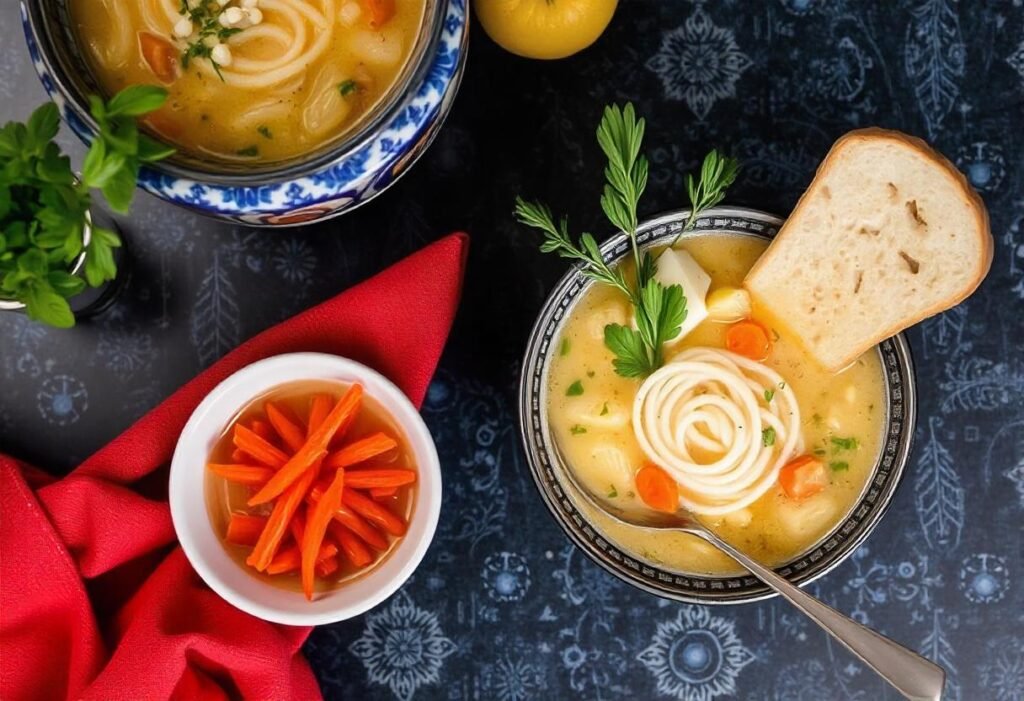Table of Contents
Introduction

Psarosoupa, the classic Greek fish soup, is full and dense with a strong aroma as if an emanation of the Mediterranean. And it is simply fantastic as food, especially for people who love fish pieces of fish are beautifully tender and very slightly textured, like morsels cooked in whole vegetables, inside an aromatic broth. Psarosoupa is not a dish, it’s a party to the sea and a tribute to the beautiful richness of Greek culinary traditions. This dish is for a balance of flavors and textures inside you just could not possibly go wrong warming your heart and soul.
Having been born out of areas of the shore where fresh fish could easily be bought, Psarosoupa has, for centuries now, been a household staple in Greece. Simple yet at the same time allowing room for the guts and gizzards of nature to take center stage in front of both home dining tables and tavernas. In this comprehensive guide, we will discover the history of psarosoupa, its main ingredients, its cooking technique step by step, and variation ideas along with serving concepts so that you can enjoy this fantastic broth in your kitchen.
The Rich History Behind Psarosoupa
Psarosoupa history can be said to be almost inextricable with Greece’s maritime culture. Among the numerous broths based on fish, psarosoupa lets us know that, since time immemorial, fish has been part of the Greek diet, thereby proving this country’s close affinity to the sea. All those who were fishermen living along the seashore were bound to convert their catches into soups rich and hearty by using every part of the fish to waste nothing and add up to the flavors available in those parts.
Psarosoupa had always been a genuine dish consumed during the advent of cold weather. In big vessels placed above the flames, well, there were just sitting with people to share stories. This aspect of cooking and eating culture doesn’t miss this day.
In time, it has advanced Greece, though traditional components changed with added elements for a stronger flavor and taste in its recipe. Over time, different regions and their special ingredients and ways of cooking therefore lead to tremendous differences between regional dishes. For instance, on the islands of the Aegean Sea, cooks will add a dash of a bit more herb or spice. On the mainland of Greece, this is simply to emphasize quality fish. This anecdote does not only tell another version of the dish but also the story of this region’s gastronomic identity.
Key Ingredients
Fresh Seafood: What to Choose for Your Psarosoupa
The base of any good psarosoupa is built on seafood. The best psarosoupa is made with the freshest fish you can find the quality of the seafood could make or break the broth. Some common staples include:
- White Fish: A good variety of white fish such as cod, sea bass, snapper, or haddock is great to use when preparing psarosoupa. The beauty of preparing white fish is that it won’t overpower the dish with any strong flavor which may clash with the flavors coming from the spices and herbs which add their value to the cooking pot.
- Shellfish: Some shrimp, mussels, or clams are added to make the soup that much richer in flavors and textures. Flavors and textures are present with every single bite you take from your shellfish.
When you do get fish, get some firm to the touch and with a clean sea-like smell. Ideally, it would be best to drop by at a local fish market so you can have the freshest catch of the day. The secret to a great psarosoupa is really in how you choose the ingredients.
Essential Herbs and Spices to Elevate Your Dish
Psarosoupa is a medley of herbs and spices. Among them, there are a few more important ones that need a special mention.
- Dill: Dill is the main hero of psarosoupa. It is refreshing, with a hint of sweetness. Fresh dill should always be used. Dry dill will also serve the purpose if fresh dill is not available.
- Parsley: The chopped parsley is used for psarosoupa. This adds beauty to the psarosoupa along with the flavor.
- Thyme: A few sprigs of thyme add an earthy flavor, pairing well with the fish and veggies.
- Lemon Zest and Juice: To add, lemon zest that contains an acid will reduce the richness of the broth. Can be eaten with lemon juice for added flavor.
- Black Pepper and Red Pepper Flakes: These add a warm lipid feel to the soup. Use your taste, naturally.
Optional Add-Ins: Customize Your Psarosoupa
For an even more authentic version of this beloved Greek soup, add your personal favorites. Here are a few ideas for optional add-ins to your psarosoupa:
- Vegetables: Carrots, potatoes, leeks, and celery really give the soup great heartiness and nutrients. While you are adding flavor, you are also adding texture.
- Wine: This can be added if you want to deepen the broth further. The dry splash of the white wine will add and enrich your broth. Use a wine you drink since the flavor gets amplified in the final dish.
- Cream or Coconut Milk: Adding a small amount towards the end of cooking will add a rich, creamy feel to this dish.
The beauty of psarosoupa lies in its versatility; do not hesitate to experiment with flavors that resonate with you, or use what you have on hand.
Step-by-Step Guide to Making Psarosoupa
Preparing Your Seafood
Prepare your seafood. If you are cooking whole fish, clean them under cold running water and pat dry. Scale and gut the fish if necessary. Cut your filets into smaller portions so they will cook evenly. Run your shellfish under a faucet, scrubbing away any sand or grit. The better you prepare, the better the flavors and texture will be.
Building the Broth: The Heart of Psarosoupa
Heat a couple of tablespoons of good olive oil in a large pot over medium heat. Add extremely finely chopped onions and fry them until they are softened to translucency. The onions from the bed of your broth; make your broth sweet and deep.
Once the onions softened, I added minced garlic, cooking it for another minute and not letting it darken. It had an aromatic fragrance.
Add about six cups of water or fish stock. If you are using water, it’s no disadvantage to add a fish bouillon cube or two for richness. Bring the mixture gently to a simmer and let the flavors meld together beautifully. A splash of white wine can be added at this point for extra depth of flavor.
Combining Flavors: Cooking Your Psarosoupa
At this stage, the broth is nearly ready to boil, which is why it is a perfect time to add vegetables. Scratched carrots, potatoes, and leeks are placed in the portion and thrown into a pot. They have to be cooked for at least 10-15 minutes longer in order to cook through. This step alone adds flavor to the broth and also guarantees the cooked vegetables are well cooked.
When the vegetables have softened the seafood is carefully added to the pot without stirring vigorously so as to break up the fish. Cook this soup for another 10-15 minutes or until the seafood is done, and is flaky in texture, when tested with a fork.
Add in the last few minutes of cooking: Finely chopped or tear 4 good handfuls of fresh dill and a good handful of fresh parsley; sprinkle with salt and pepper to taste, and lemon juice. The dynamic colors and aromatic herbs will transform your kitchen into a culinary haven in itself and drive everyone to the table.
Serving Suggestions
Pour your psarosoupa into deep bowls, so each serving can contain a nice combination of seafood and vegetables. A pinch of fresh herb and a lemon twist added to it finish the feel. This goes well served with crusty bread for dipping in the savory broth.
But if you would like to have more than just pasta, you can have this with a highly acidic Greek salad with fresh tomatoes, cucumbers, olives, and feta cheese dressed in olive oil and lemon. And then there’s the drink: As for the last drink, a chilled white wine should reach the table – probably a good Assyrtiko or just Sauvignon Blanc.
Check Out: Fish Spicy Soup.
Nutritional Benefits
Psarosoupa is not only tasty but also healthy. Here are some nutritional benefits of this deliciously healthy delight of the dish:
- Rich in Omega-3 Fatty Acids: When it comes to omega-3 fatty acids – this is used in the body for heart and brain health- seafood in psarosoupa is rich in this nutrient. The consumption of omega-3s can be made better through a regular diet.
- High in Protein: The fish contains proteins that occur in a high quality to be used in the fixing of muscles, adaptive immunity, and in the maintenance of healthy tissues.
- Packed with Vegetables: The presence of vegetables adds to higher fiber, vitamins, and minerals. This ensures that the diet is rather well-balanced. It is rich in important nutrients like carrots, and potatoes, as well as herbs, responsible for good health.
- Low in Calories: In general, Psarosoupa tends to be low in calories so it’s a great choice for someone looking to enjoy a fulfilling meal without overeating.
- Hydrating and Comforting: The broth is great for hydrating and comforting – perfect for cold days or those with some slight illness.
Variations

Now that you know the pleasure of this classic Psarosoupa, there are many variations you can explore:
- Spicy Psarosoupa: Add some chopped-up chili peppers, or perhaps throw in a dash of hot sauce. The flavors will give that soup a great peppery zing.
- Mediterranean-Style Psarosoupa: Add some kalamata olives, capers, and sun-dried tomatoes to the mixture for a salty mix of flavors similar to the regions of the Mediterranean.
- Creamy Psarosoupa: Finish with a pour of cream or coconut milk to give it a creamy texture. This feels really great in cold months.
- Vegetarian Psarosoupa: Replacement can turn this seafood soup into a meatless alternative by substituting it with substantial mushrooms and tofu and vegetable broth instead of fish stock. This also can be as lively and fulfilling.
- Seasonal Variations: You can add seasonal vegetables like zucchini in summer or root vegetables in autumn, thus keeping you having this psarosoupa throughout the year.
Conclusion
There’s much more to cooking homemade psarosoupa than just merely going through the motions is the upliftment from joy while creating something nourishing and delicious. It is in this way that the preparation of this traditional dish brings vibrant Mediterranean flavors straight to your doorstep, filling it with delightful aromas and warm memories. Whether it is a cold evening or you’re serving it to friends and family, psarosoupa is that dish that serves for bonding and warmth.
As you navigate through the territory of psarosoupa, you should not shy away from claiming it. Try your ingredients and spices and types of serving so you can come up with a variation you would like best for your taste buds. So gather your ingredients, invite family and friends, and enjoy the great process of making and relishing psarosoupa.
For more details: Click Here.
FAQs
What types of fish are best for psarosoupa?
Best fish: cod, sea bass, snapper. You can add shrimp or mussels to it and give it a more savory flavor.
Can I make psarosoupa with frozen seafood?
Absolutely! In case you are working with frozen seafood, thaw it completely and clean it first before adding it in the pot.
How do I store leftovers of psarosoupa?
Chill leftovers in a tight container for up to three days. Heat them on top of the stove at low heat.





